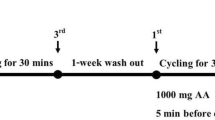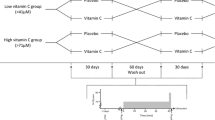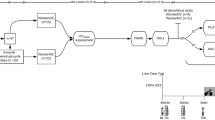Abstract
The purpose of this study was to investigate the individual and combined antioxidant effects of menstrual cycle phase-related alterations in blood serum oestradiol concentrations and of dietary vitamin E supplementation on exercise-induced oxidative stress and muscle performance. A group of 18 sedentary women, aged 19–35 years, were given supplements of 300 mg α-tocopherol (n=10) or placebo (n=8) daily during the course of two menstrual cycles. The subjects exercised the knee isokinetically to exhaustion after cycling submaximally at 50% maximal oxygen uptake during the menstrual and preovulatory phases of their menstrual cycles. Blood samples were taken before and after the exercise, to evaluate haematocrit, plasma lactic acid and malondialdehyde concentrations, erythrocyte antioxidant enzymes superoxide dismutase (SOD) and glutathione peroxidase (GPx) activities and apolipoprotein B containing lipoprotein (non-high density lipoprotein, HDL, fraction) oxidation. Serum vitamin E, follicle stimulating hormone, luteinizing hormone and oestradiol concentrations were measured in pre-exercise blood samples. Neither vitamin E supplementation nor oestradiol concentrations influenced SOD and GPx activities or the susceptibility of the non-HDL fraction to oxidation while at rest. Plasma malondialdehyde concentration was unaffected by exercise, however significant reductions in erythrocyte SOD and GPx activities and increased susceptibility of the non-HDL fraction to oxidation were noted after exercise. Exercise-induced changes were reduced when oestradiol concentration was high in the preovulatory phase, independent of the serum vitamin E concentrations. In addition, both pre- (r=0.58, P < 0.05) and post-exercise (r=0.73, P < 0.001) GPx activities in placebo administered subjects were positively correlated with oestradiol concentrations. In conclusion, these findings suggest a better protective role of oestradiol against oxidative injury, compared to vitamin E. Exhausting muscle performance was, however, not influenced by vitamin E supplementation and/or cycle-phase related changes in oestradiol concentrations.
Similar content being viewed by others
Author information
Authors and Affiliations
Additional information
Accepted: 18 September 2000
Rights and permissions
About this article
Cite this article
Akova, B., Sürmen-Gür, E., Gür, H. et al. Exercise-induced oxidative stress and muscle performance in healthy women: role of vitamin E supplementation and endogenous oestradiol. Eur J Appl Physiol 84, 141–147 (2001). https://doi.org/10.1007/s004210000331
Issue Date:
DOI: https://doi.org/10.1007/s004210000331




